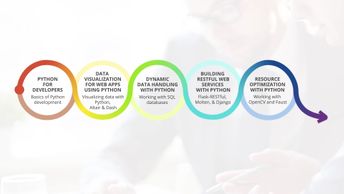Final Exam: Dynamic Data Handling with Python - add a foreign key constraint between tables
- analyze the common and distinct values in two tables using various petl functions
- automate operations using triggers
- calculate aggregate statistics for a field in a table using the aggregate function
- configure an httpx.Cookies instance to send a collection of properties to a remote server
- create and invoke stored procedures
- create and use a SQL primary key constraint with autoincrement
- create a table and insert rows into it
- create a table in SQLite and read it into petl using SQLAlchemy and SQLite3
- create SQL indexes on tables
- create tables using object relational mapping
- define and submit a POST request containing JSON and binary data
- download a set of files sequentially using HTTPX
- drop a table, recreate it, and insert rows into it
- execute alter operations to add constraints and indices to tables
- explore different ways to use logical operators for querying data
- get data from MS Excel and perform basic operations on the data
- identify the different options available to stream large volumes of data in an HTTP response
- identify when a redirect has taken place upon submitting an HTTP request
- implement an httpx.Cookies instance to send a collection of properties to a remote server
- implement check constraints
- implement insert and delete operations
- implement slicing, dicing, and merging operations on petl data tables
- implement specialized types of joins such as anti joins and cross joins
- implement split operations on data stored within petl tables
- insert and edit columns and rows in petl data tables
- insert and edit rows and columns in petl data tables
- insert data into views
- insert rows into a table
- install petl and create a basic petl data table out of toy data
- install SQLAlchemy and connect to MySQL
- install SQLAlchemy and connect to MySQL
- install the latest available version of HTTPX on your system
- limit the amount of time your app spends waiting to get served a response to an HTTP request using timeouts
- make use of the rowreduce() function to reduce rows and compute aggregate statistics
- map fields in a petl table to transformation based on functions
- perform insert and delete operations
- perform joins based on overlapping intervals rather than absolute values
- perform SQL like equi-joins on petl data tables
- perform various grouping operations on the data in a table
- perform various import and export operations on CSV, TSV, and TXT files.
- perform various update and replace operations on petl data tables by defining functions to perform transformations
- query data using object relational mapping
- read in data from the serialized pickle and XML file formats
- read JSON data, perform various operations, and export it to a persistent format
- recall the types of exceptions that can be encountered when sending and processing requests with HTTPX
- recognize the messages conveyed in the different status codes sent in an HTTP response
- recognize the types of exceptions that can be encountered when sending and processing requests with HTTPX
- recognize when a redirect has taken place upon submitting an HTTP request
- retrieve information about a remote resource using a HEAD request
- submit data to a remote server using a POST request with HTTPX
- submit HTTP GET requests with one or more parameters using HTTPX
- use an httpx.Cookies instance to send a collection of properties to a remote server
- use slicing, dicing, and merging operations on petl data tables
- use the aggregate function to calculate aggregate statistics for a field in a table
- use the facet petl function to define filters on specific fields in a table
- use the fetchmany() function to retrieve the output of a select query
- use the HTTPX AsynClient to download a set of files asynchronously
- use triggers to automate operations
- work with transaction aborts
|


